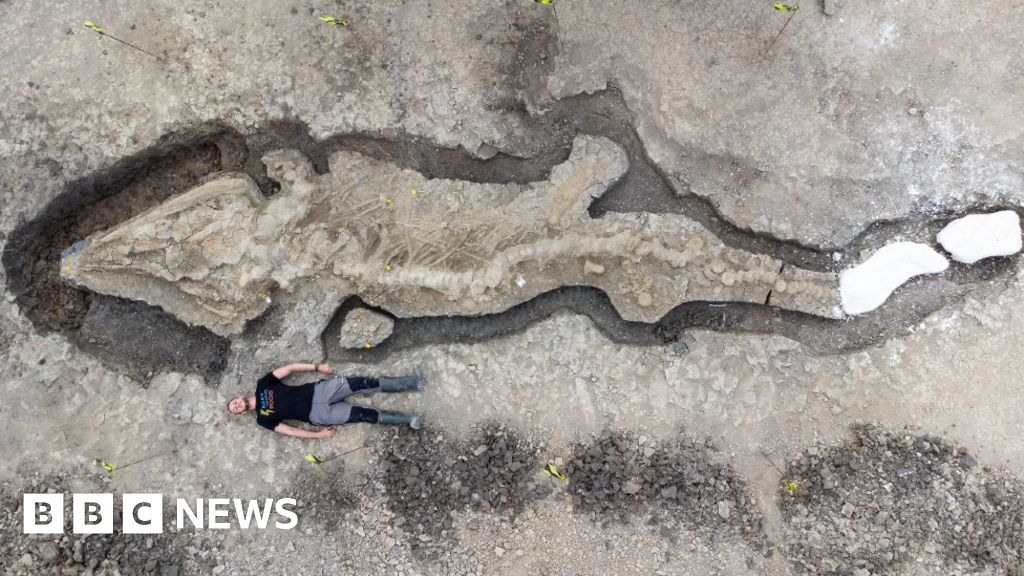Image source, Anglian Water
Palaeontologist Dr Dean Lomax (being used for scale) said it was an honour to lead the excavation of a 33ft (10m) long ichthyosaur fossil in Rutland
Most of the UK’s dinosaur fossils have been discovered in southern England at coastal sites such as the Jurassic Coast of Dorset and the Isle of Wight, the clay quarries of Surrey or the Cotswolds.
But in February 2021, Britain’s largest fossil of a sea predator around at the time of the dinosaurs, was uncovered in Rutland Water Nature Reserve in the East Midlands.
The 33ft (10m) long ichthyosaur fossil, which was about 180 million years old, was discovered during the routine draining of a lagoon island for re-landscaping.
Found by Joe Davis of Leicestershire and Rutland Wildlife Trust, it was then excavated by a team led by ichthyosaur expert Dr Dean Lomax and palaeontologist Nigel Larkin.
Image source, Anglian Water
Ichthyosaurs became extinct around 90 million years ago
Similar in shape to dolphins, the reptiles – known as sea dragons – varied in size from 3ft (1m) to 82ft (25m).
As well as being the biggest, it was also the most complete fossil of its kind found in the UK and is thought to be the first ichthyosaur of its species (Temnodontosaurus trigonodon) found in the country.
World’s first dinosaur
Image source, Oxford University Museum of Natural History
A partial jaw of Megalosaurus, the iconic fossil used in the very first scientific description of a dinosaur
During the 17th and 18th centuries, people around Oxfordshire began finding mysterious bones.
Items such as a single tooth or part of a leg bone were puzzled over by academics, but it wasn’t until around 1818 that geologist and theologian William Buckland began to study the remains, including one discovered in a slate quarry in the village of Stonesfield.
In 1824, Buckland used this bone of a massive reptile-like creature in the first scientific description of a dinosaur – Megalosaurus – meaning “great lizard”.
On display in the university’s Museum of Natural History, the dentary bone is just the front half of the lower jaw, and has serrated teeth which points to the creature being a meat eater.
Fast forward to 1842, and the term ‘dinosaur’ was coined by biologist Richard Owen to describe a group of animals including Megalosaurus and other giant lizards.
Britain’s oldest human fossil
Prof Chris Stringer CBE at the site where the Boxgrove hominin tibia was discovered in 1993
Boxgrove Man is a 500,000 year old fossil, thought to belong to the species Homo heidelbergensis, an extinct relative of modern humans.
Discovered in 1993 in Boxgrove, West Sussex, the remains of two pieces of the tibia (shinbone) and two teeth, are considered to be the oldest human fossils ever discovered in Britain.
Archaeologist Mark Roberts and his team at University College London made the discovery at the world famous archaeological site.
They also believed the site was a spring or water hole where hominid hunters butchered giant deer and rhinos, as primitive flint and antler tools used were also uncovered.
Image source, NATURAL HISTORY MUSEUM, LONDON/SCIENCE PHOTO LIB
A fossil tibia or shinbone from Homo heidelbergensis, discovered in 1993 in a quarry
The site is an exceptionally preserved 26km-wide ancient landscape of stone, and provides a virtually untouched record of early humans, according to Dr Matthew Pope, associate professor at UCL’s Institute of Archaeology.
The best preserved area of the site is known as the Horse Butchery Site, as it is where a large horse was slaughtered and processed some 480,000 years ago.
What is a fossil?
- Fossils are the preserved remains of plants and animals that were buried in sediments, such as sand and mud, under ancient watercourses
- Soft tissues decay soon after death, but harder elements such as bones or teeth can be replaced by minerals that eventually harden into rock
- In order for a fossil to form, the specimen must be rapidly buried by sediments that were previously suspended in water
- This isolates the remains from the biological and physical processes that would otherwise break up or dissolve them
‘One of UK’s biggest Ice Age discoveries’
Image source, DigVentures
The remains of at least five Ice Age mammoths were found at the quarry
In 2017, a couple hunting for marine fossils at a former quarry just outside Swindon, Wiltshire, noticed something unusual protruding from the mud.
It turned out to be the top of a huge fossilised leg bone of a mammoth. Sally and Neville Hollingworth had stumbled across the discovery of a lifetime – a mammoth graveyard in the old prehistoric riverbed of the Thames.
When they returned to dig up more mammoth bones and tusks, Sally discovered a stone hand axe made by an early human.
Unlike most mammoth discoveries that date back tens of thousands of years, the fossils appear to be hundreds of thousands of years old.
Image source, BBC/Windfall Films
Sir David Attenborough joined Ben Garrod and a team of investigators at a mammoth graveyard to explore whether Neanderthals might have killed the ice age beasts
At the time, Historic England chief executive Duncan Wilson said the discovery represented “one of Britain’s most significant Ice Age discoveries in recent years”.
“The findings have enormous value for understanding the human occupation of Britain, and the delicate environmental evidence recovered will also help us understand it in the context of past climate change,” he said.
T. rex relative
Image source, Michael Garlick
Dinosaur fossils were discovered on the beach at Shanklin
In 2019, fossils thought to belong to a relative of the T. rex were found by three different people on the Isle of Wight.
Palaeontologists at the University of Southampton believe the four bones found at Shanklin beach belong to a new species of theropod dinosaur.
It lived in the Cretaceous period, 115 million years ago, and is estimated to have been up to 13ft (4m) long.
Named Vectaerovenator inopinatus, it belongs to the group of dinosaurs that includes Tyrannosaurus rex and is a distant predecessor of modern-day birds.
Robin Ward, a regular fossil hunter from Stratford-upon-Avon, Warwickshire, was visiting the Isle of Wight with his family when they made their discovery, as was James Lockyer, from Spalding, Lincolnshire, when he found another of the bones.
Paul Farrell, from Ryde, was walking along the beach kicking stones, and came across what looked like a bone from a dinosaur.
“I was really shocked to find out it could be a new species,” he said.
Image source, Darren Naish
This silhouette of a theropod indicates where in the body the bones were from
The Latin name Vectaerovenator inopinatus, which translates to “unexpected Isle of Wight air-filled hunter”, refers to the large air spaces found in some of the bones from the neck, back and tail of the creature.
It was one of the traits that helped the scientists identify its theropod origins.
These air sacs, also seen in modern birds, were extensions of the lung, and it is likely they “helped fuel an efficient breathing system while also making the skeleton lighter”, the University of Southampton said.

Dr. Thomas Hughes is a UK-based scientist and science communicator who makes complex topics accessible to readers. His articles explore breakthroughs in various scientific disciplines, from space exploration to cutting-edge research.








